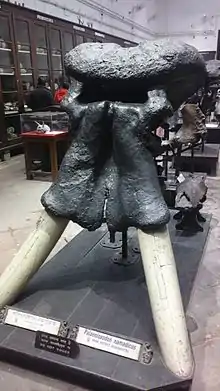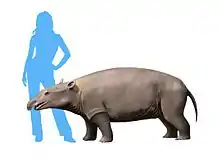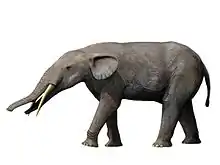Palaeoloxodon
Palaeoloxodon is an extinct genus that contains the various species of straight-tusked elephants. The genus originated in Africa during the Pliocene, and expanded into Eurasia during the Pleistocene. One species, Palaeoloxodon namadicus, was possibly the largest known land mammal.[2][3] The genus has a long and complex taxonomic history, and at various times, it has been considered to belong to Loxodonta or Elephas, but today is considered distinct.
| Palaeoloxodon | |
|---|---|
.JPG.webp) | |
| Skeleton of Palaeoloxodon huaihoensis at National Museum Of Nature Science | |
| Scientific classification | |
| Kingdom: | Animalia |
| Phylum: | Chordata |
| Class: | Mammalia |
| Order: | Proboscidea |
| Family: | Elephantidae |
| Subfamily: | Elephantinae |
| Tribe: | Elephantini |
| Subtribe: | †Palaeoloxodontina |
| Genus: | †Palaeoloxodon Matsumoto, 1924[1] |
| Type species | |
| Elephas namadicus naumanni Makiyama, 1924 | |
| Species | |
| |
Taxonomy
In 1924, Hikoshichiro Matsumoto circumscribed Palaeoloxodon as a subgenus of Loxodonta. It included the "E. antiquus—namadicus group", and he designated "E. namadicus naumanni Mak." as its type species.[1]
Palaeoloxodon was later thought to be a subgenus of Elephas, but this was abandoned by 2007.[4] In 2016, a DNA sequence analysis of P. antiquus suggested that its closest extant relative may be the African forest elephant, L. cyclotis. The paper argues that P. antiquus is closer to L. cyclotis than L. cyclotis is to the African bush elephant, L. africana, thus invalidating the genus Loxodonta as currently recognized.[5] A second study suggested P. antiquus had a complex hybridsation history, with over 60% of its DNA coming from a lineage closest to but outside the two extant Loxodonta species, around 6% from Mammuthus and 30% from a lineage closer to L. cyclotis than L. africana. The hybridisation probably took place in Africa, where Paleoloxodon was dominant for most of the Pliocene and Early Pleistocene[6]
Some notable species are:
- P. antiquus (Europe, Middle East, Asia) was larger than the modern African elephant.
- P. chaniensis (Crete), dwarf elephant
- P. cypriotes (Cyprus), dwarf elephant
- P. falconeri (Sicily and Malta), dwarf elephant
- P. mnaidriensis (Sicily), dwarf elephant
- P. namadicus (Asia), the largest in its genus, and possibly the largest terrestrial mammal ever
- P. naumanni (Japan), dwarf elephant and possible subspecies of E. namadicus
- P. recki (East Africa), the oldest (4.0 - 0.6 million years ago) and one of the largest species[7]
Description

Palaeoloxodon is noted for its distinctive parieto-occipital crest present at the top of its cranium, which was used to anchor musculature to support the skull.[8]
Evolution
Palaeoloxodon first appears in the fossil record in Africa during the early Pliocene, around 4 Mya as the species Palaeoloxodon recki. P. recki was the dominant elephant in Africa for the Pliocene and most of the Pleistocene. A population of P. recki migrated out of Africa between 0.8 and 0.6 Mya, diversifying into the radiation of Eurasian Paleoloxodon species, including P. antiquus, P. namadicus, and P. naumanni, the precise relationships of the Eurasian taxa to each other are obscure in the absence of molecular evidence. P. recki became extinct in Africa around 0.5 Mya, being replaced by the modern genus Loxodonta. The arrival of P. antiquus in Europe co-incides with the extinction of Mammuthus meridionalis and its replacement by Mammuthus trogontherii, suggesting that it might have shared a similar dietary niche and outcompeted the former.[9] P. antiquus was able to disperse onto many islands in the Mediterranean, undergoing insular dwarfism and speciating into numerous distinct varieties of dwarf elephants.
Extinction
The last mainland European Palaeoloxodon faced extinction 30,000 years ago. The Japanese species possibly survived for a little longer afterwards. Among the last straight-tusked elephants were the Mediterranean dwarf species, which died out 3,000 years ago - possibly at the hands of human hunters and introduced predators.
A Palaeoloxodon population of undetermined species is claimed to have survived in northern China until 3,000 years ago. Li Ji and colleagues from the Institute of Geographic Sciences and Natural Resources Research, Beijing, argued that teeth previously believed to belong to Asian elephants were actually those of Palaeoloxodon. Whether these belong to a new, distinctive species or actual descendants of P. namadicus is unknown. They also argued that ritual bronze vessels depicting trunks with two "fingers" must be Palaeoloxodon (which are only known from bones; their trunk characteristics are unknown) because Asian elephants only have one.[10][11] Fossil elephant experts Victoria Herridge and Adrian Lister disagree with the assignment, stating that the claimed diagnostic dental features are actually contrast artifacts created due to the low image resolution of the figures in the scientific paper, which are not evident in better-quality photographs.[12] Given that the appearance of Palaeoloxodon trunks is unknown, and the bronze depictions of animals shown in the paper are highly stylized, the argument based on bronze vessels is also unreliable. Thus, these elephants are more likely Asian elephants, as originally believed.
References
- 松本彦七郎 (1924). 日本産化石象の種類(略報). 地質学雑誌 (in Japanese). 31 (371): 255–272. doi:10.5575/geosoc.31.371_255.
- Larramendi, A. (2015). "Shoulder height, body mass and shape of proboscideans" (PDF). Acta Palaeontologica Polonica. 60. doi:10.4202/app.00136.2014.
- "Early signs of elephant butchers". BBC News. 30 June 2006.
- Shoshani, J.; Ferretti, M. P.; Lister, A. M.; Agenbroad, L. D.; Saegusa, H.; Mol, D.; Takahashi, K. (2007). "Relationships within the Elephantinae using hyoid characters". Quaternary International. 169–170: 174–185. Bibcode:2007QuInt.169..174S. doi:10.1016/j.quaint.2007.02.003.
- Callaway, E. (2016-09-16). "Elephant history rewritten by ancient genomes". Nature. doi:10.1038/nature.2016.20622.
- Palkopoulou, Eleftheria; Lipson, Mark; Mallick, Swapan; Nielsen, Svend; Rohland, Nadin; Baleka, Sina; Karpinski, Emil; Ivancevic, Atma M.; To, Thu-Hien; Kortschak, R. Daniel; Raison, Joy M. (2018-03-13). "A comprehensive genomic history of extinct and living elephants". Proceedings of the National Academy of Sciences. 115 (11): E2566–E2574. doi:10.1073/pnas.1720554115. ISSN 0027-8424. PMC 5856550. PMID 29483247.
- Turner, A. (2004) Prehistoric Mammals. Larousse
- Larramendi, Asier; Zhang, Hanwen; Palombo, Maria Rita; Ferretti, Marco P. (February 2020). "The evolution of Palaeoloxodon skull structure: Disentangling phylogenetic, sexually dimorphic, ontogenetic, and allometric morphological signals". Quaternary Science Reviews. 229: 106090. Bibcode:2020QSRv..22906090L. doi:10.1016/j.quascirev.2019.106090.
- Lister, Adrian M. (2004), "Ecological Interactions of Elephantids in Pleistocene Eurasia", Human Paleoecology in the Levantine Corridor, Oxbow Books, pp. 53–60, ISBN 978-1-78570-965-4, retrieved 2020-04-14
- Li, J.; Hou, Y.; Li, Y.; Zhang, J. (2012). "The latest straight-tusked elephants (Palaeoloxodon)? "Wild elephants" lived 3000 years ago in North China". Quaternary International. 281: 84–88. Bibcode:2012QuInt.281...84L. doi:10.1016/j.quaint.2011.10.039.
- Warwicker, Michelle (19 December 2012). "Extinct elephant 'survived late' in North China". BBC News.
- Switek, Brian. "Bronze Age Art Sparks Debate over the Straight-Tusked Elephant".


